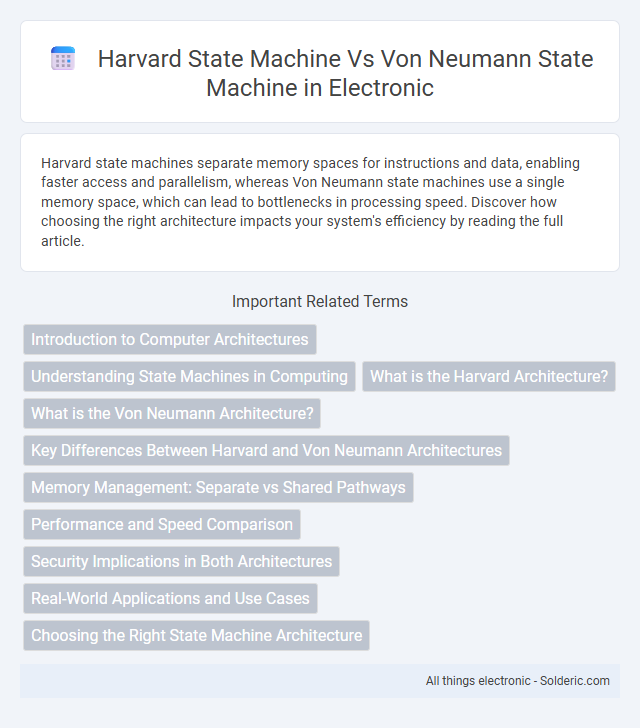Harvard state machines separate memory spaces for instructions and data, enabling faster access and parallelism, whereas Von Neumann state machines use a single memory space, which can lead to bottlenecks in processing speed. Discover how choosing the right architecture impacts your system's efficiency by reading the full article.
Comparison Table
| Feature | Harvard State Machine | Von Neumann State Machine |
|---|---|---|
| Memory Architecture | Separate memories for instructions and data | Single shared memory for instructions and data |
| Data and Instruction Access | Parallel access, simultaneous read/write | Sequential access, shared bus limits simultaneous access |
| Performance | Higher throughput due to parallelism | Lower throughput, limited by bus contention |
| Complexity | More complex hardware design | Simpler hardware design |
| Use Cases | Embedded systems, DSPs, where speed critical | General purpose computing and systems with less performance constraint |
| Data Bottleneck | Minimized due to separate memory paths | Prone to Von Neumann bottleneck |
Introduction to Computer Architectures
The Harvard state machine architecture separates memory storage and signal pathways for instructions and data, enabling simultaneous access and faster processing speeds. In contrast, the Von Neumann state machine uses a single memory and bus system for both instructions and data, which can cause bottlenecks known as the Von Neumann bottleneck. Understanding these differences is crucial for optimizing Your system's performance in computer architecture design and execution.
Understanding State Machines in Computing
Harvard state machines separate memory for instructions and data, enhancing parallelism and speed in computing processes compared to Von Neumann state machines, which use a unified memory system that can create bottlenecks. This architectural distinction affects how your processor handles fetch and execution cycles, with Harvard designs typically enabling faster and more efficient state transitions. Understanding these differences is crucial for optimizing computing tasks and designing systems tailored to specific performance needs.
What is the Harvard Architecture?
Harvard Architecture is a computer design that separates memory storage and signal pathways for instructions and data, allowing simultaneous access and improving processing speed. Unlike the Von Neumann architecture, which uses a unified memory for both programs and data, Harvard Architecture enhances performance by reducing bottlenecks during execution. Your device benefits from this distinction by achieving more efficient instruction fetching and data handling.
What is the Von Neumann Architecture?
The Von Neumann Architecture is a computer design model that uses a single memory space to store both instructions and data, enabling sequential processing by the central processing unit (CPU). In contrast, the Harvard Architecture separates memory for instructions and data, allowing simultaneous access and potentially faster execution. The Von Neumann design's unified memory simplifies programming but can lead to bottlenecks known as the Von Neumann bottleneck.
Key Differences Between Harvard and Von Neumann Architectures
Harvard architecture features separate memory spaces for instructions and data, enabling simultaneous access and faster processing, while Von Neumann architecture uses a single shared memory for both, causing potential bottlenecks. Harvard machines are often preferred in digital signal processing due to their parallel data handling, whereas Von Neumann designs offer simplified hardware and easier programming. Your understanding of these key differences can guide optimal processor selection based on performance and application needs.
Memory Management: Separate vs Shared Pathways
Harvard state machines utilize separate memory pathways for instructions and data, enabling parallel access that significantly boosts processing speed and efficiency. Von Neumann state machines rely on a single shared memory pathway, which can create bottlenecks as instruction fetch and data operations compete for access. Your choice between these architectures can impact system throughput and memory management strategies.
Performance and Speed Comparison
Harvard state machines offer faster performance by utilizing separate memory storage and buses for instructions and data, enabling simultaneous access and reducing bottlenecks found in Von Neumann state machines, which use a unified memory for both. The parallel data and instruction paths in Harvard architectures improve throughput and clock speed, making them ideal for high-speed digital signal processing. In contrast, Von Neumann machines experience slower execution due to the sequential fetching of instructions and data from the same memory resource, creating a bottleneck known as the Von Neumann bottleneck.
Security Implications in Both Architectures
Harvard state machines separate instruction and data memory, reducing vulnerability to code injection attacks by isolating executable code from writable data spaces, enhancing security. Von Neumann state machines use a unified memory for instructions and data, increasing risks such as buffer overflow exploits due to the shared memory space. The architectural separation in Harvard designs provides inherent protection against unauthorized code modification, making it more secure for critical applications.
Real-World Applications and Use Cases
Harvard state machines excel in digital signal processing and embedded systems by separating instruction and data memory, enabling faster and more efficient execution in real-time applications such as microcontrollers and DSP chips. Von Neumann state machines, with their shared memory architecture, are widely used in general-purpose computing, including desktop processors and servers, providing flexibility and easier programming for complex tasks. Real-world applications leverage Harvard architecture for performance-critical tasks, while Von Neumann machines dominate in environments requiring versatile computational capabilities and ease of software development.
Choosing the Right State Machine Architecture
Choosing the right state machine architecture depends on the specific application and performance requirements; Harvard state machines separate instruction and data memory, enabling faster and more efficient processing for complex tasks, while Von Neumann state machines use a single memory for both, simplifying design but potentially causing bottlenecks. Harvard architecture excels in applications requiring high-speed data access and parallelism, often found in embedded systems and signal processing. Your decision should consider the trade-offs between speed, complexity, and cost to determine the best fit for your design goals.
Harvard state machine vs Von Neumann state machine Infographic

 solderic.com
solderic.com